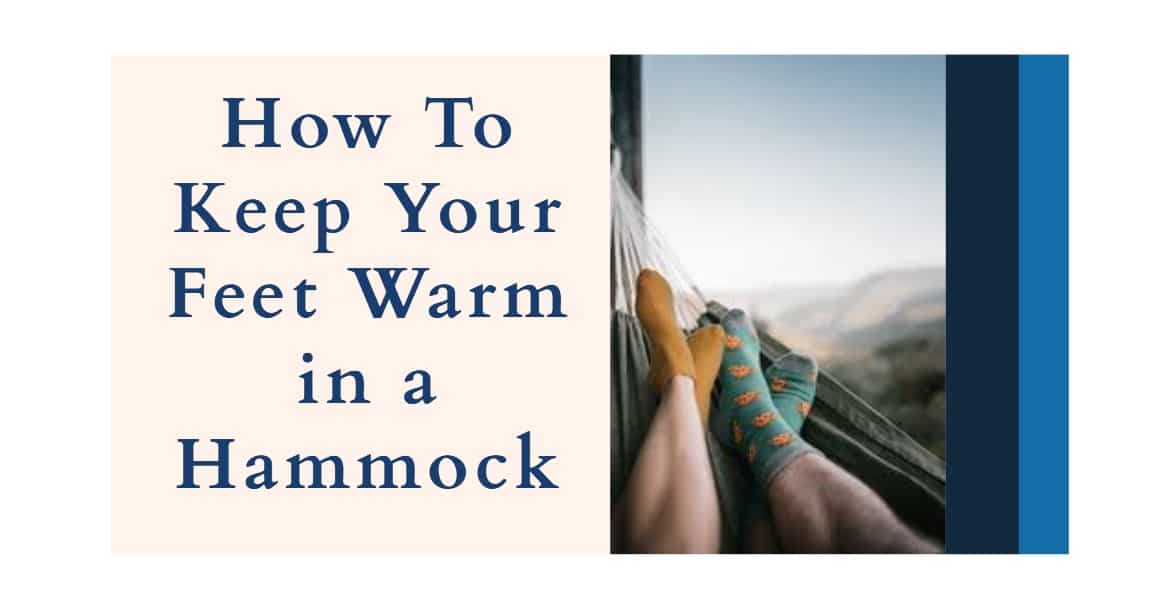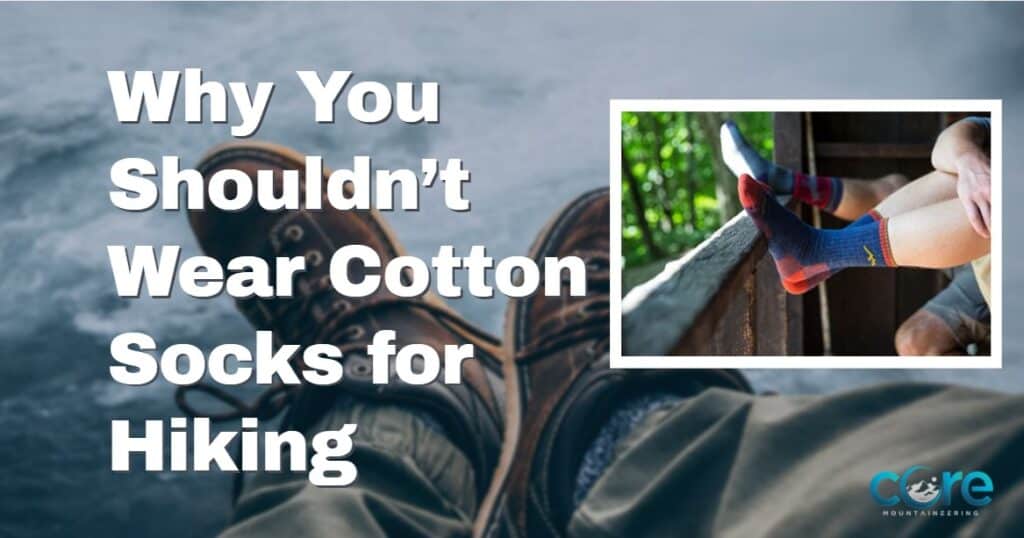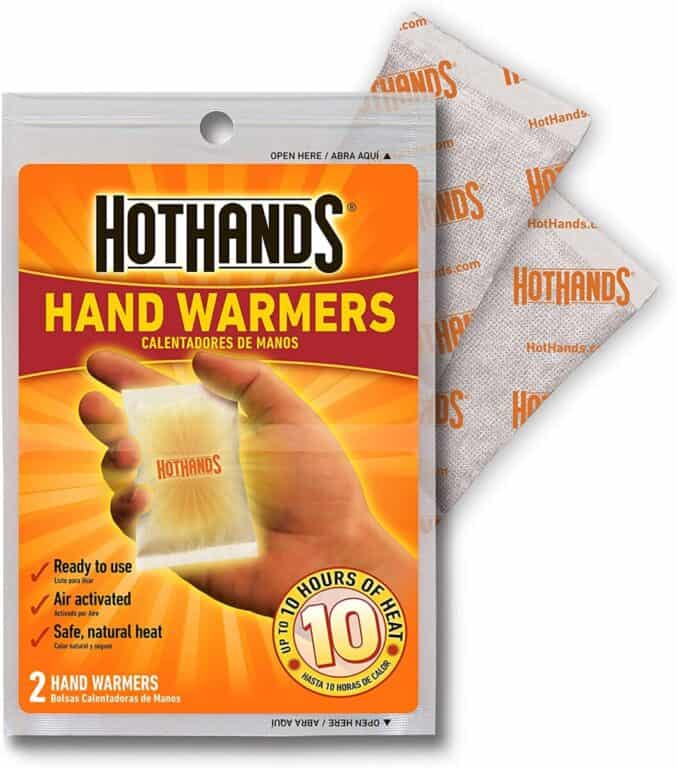One of the biggest problems people face when hammock camping is figuring out how to keep their feet warm. It’s a complaint you hear all the time, “the rest of my body is warm but my feet always seem to get cold!”
To keep your feet warm while camping in a hammock, you need to focus on optimizing a few key factors. These include finding ways to generate and retain heat, keeping your feet and socks dry, increasing blood flow, and using proper insulation techniques.
The most effective methods will vary based on how cold the weather is and how your body typically reacts to temperature changes and personal comfort preferences.
Let’s take a look at the wide variety of techniques and foot-warming philosophies used to help people keep their feet warm in a hammock. Keep in mind; these strategies can be mixed and matched to suit your individual needs.
Eat a Snack and Keep Hydrated to Stay Warm
When your body breaks down food, it produces internal heat. This process is known as thermogenesis, and when used correctly, it can be a serious biohack for maintaining body heat.
Try eating a light snack consisting of protein, carbs, or healthy fats a little before going to sleep.
This will jumpstart your metabolism and help raise your internal body temperature.
The higher your core body temperature, the warmer your feet will stay.
Keeping well hydrated is also critical to maintaining your body’s internal temperature. When you become dehydrated, your body restricts blood flow and causes your skin to get cold quicker.
Since your extremities are the first area of the body to lose blood when you become dehydrated, your feet will feel that chill first.
Also important to mention, if you’re making an effort to stay hydrated, be sure to answer the call of nature directly before you go to sleep. This is important because your body wastes energy that could be used to keep you warm in an attempt to warm the excess fluid in your bladder.
Keep Your Head and Body Warm
When your core body temperature drops, blood is drawn from your extremities to warm and protect vital organs. This means that if the rest of your body is not protected against the cold, your feet will likely be the first ones to suffer.
Ensure you layer correctly, wear a warm hat, and have the right sleeping bag to help keep your body warm and prevent blood and heat loss from your feet.
Columbia makes some thick camping beanies that we recommend, you can check them out on Amazon here.
Decrease the Elevation of Your Feet
When you keep your feet elevated for long periods of time, blood flow decreases, and your feet get colder quicker. It’s not always easy to maintain a tight and level hammock setup, but the less elevated your feet are, the warmer they’ll stay.
Pulling the hammock as tight as possible between the two anchor points will help level out your feet. You can also try securing the hammock’s foot side slightly lower than the head side to compensate for the natural foot elevation that occurs.
Bridge hammocks are a popular alternative for someone looking for a more level sleeping setup. People typically choose bridge hammocks because they find them more comfortable to sleep in than traditional hammocks.
Still, it also serves the dual purpose of reducing that cold-inducing foot elevation.
Warm Up Your Feet Before Getting in the Hammock
It’s challenging to keep your feet warm in a hammock if they’re cold to start with. For this reason, it’s essential to focus on keeping your feet warm in the hours before you go to sleep.
The first thing you may want to do after finishing up a long day of hiking is to change out of the socks you were wearing all day into a new, dry pair. The socks you were walking around in are bound to be sweaty and damp, causing your feet to get cold quickly.

Once you’ve changed socks and have your shoes back on, take a piece of foam or any firm insulating material and put it under your shoes when you’re standing or sitting around for a while. This helps add an extra layer of protection against the cold ground.
In addition to taking preventative measures against the cold, you can also actively warm your feet. Consider keeping your feet close (but not too close!) to a fire or using a chemical foot/toe warmer to heat your feet right before bed.
It can also help increase blood flow to your feet by stretching, wiggling your toes, or doing some light activity like walking or jumping.
Properly Dry Your Feet
Dry is warm. It’s a core principle that underlies all efforts to stay warm while camping. Once your feet, or any part of your body for that matter, becomes wet or damp, they’re far more likely to become cold.
So when trying to prevent our feet from getting cold, any measures we can take to keep our feet dry works to our advantage.
Drying your feet completely when changing socks is crucial.
Be sure whatever you’re using to dry your feet is bone dry itself. You can also use alcohol wipes to dry your feet’s skin out down to the pores.
Stopping your feet from sweating in the first place is also an effective way to prevent them from getting cold. To do this, some people suggest using antiperspirant spray or cream on your feet daily for up to a week before a trip and continuing use throughout the trip.
Choose the Right Socks
After you’ve adequately dried your feet and are getting ready for bed, you’re going to want to change into a new pair of socks. Not just any socks will do, though. While certain synthetic materials may be best for hiking and active use, they’re not nearly as effective for keeping your feet warm at night.
The most widely recommended socks to sleep in are dry, loose-fitting, thick wool socks.
If you want to find the best pair of hiking socks check out our article, Why You Shouldn’t Wear Cotton Socks for Hiking – What You Should Wear Instead.
Keep Your Feet Dry
Wearing dry socks is easily the most crucial factor here. If you’re wearing the socks you’ve been sweating in all day to bed, your feet are bound to get cold as the moisture pulls heat from your skin.
Consider changing your socks after the day’s activities to prevent your feet from getting cold while relaxing at camp and again directly before you get into bed.
Come prepared with multiple changes of socks for the trip and if you’re on an extended trip, plan out ways to dry out used socks.
Loose Fitting Socks
Wearing loose-fitting socks is often overlooked but critical to keeping your feet warm. When your socks are too tight, especially around the elastic band at the calves, they constrict blood flow to the feet.
This decrease in blood flow will cause your feet to get cold more quickly.
To avoid this problem, you can buy your socks a size too big, purchase specialty socks made for diabetics, or just wear an old pair that are worn down and have lost elasticity. You won’t be hiking in loose-fitting socks, they’re only for sleeping in.
Thick Wool Socks
Wool is naturally warm, provides excellent insulation, and is the most recommended sleeping sock material by cold weather campers.
The material is woven in a way that traps air within the sock and prevents heat loss. It’s also thick and doesn’t compress under your foot’s weight, which maximizes insulation between your skin and the cold.
You can purchase wool socks in different thicknesses, which are sometimes referred to as “loft.” High loft is the thickest and recommended for colder weather, but you can also find lower loft wool socks for more moderate temperatures.
For thick warm wool socks take a look at HOT FEET Wool Socks. See if they are still available on Amazon still.
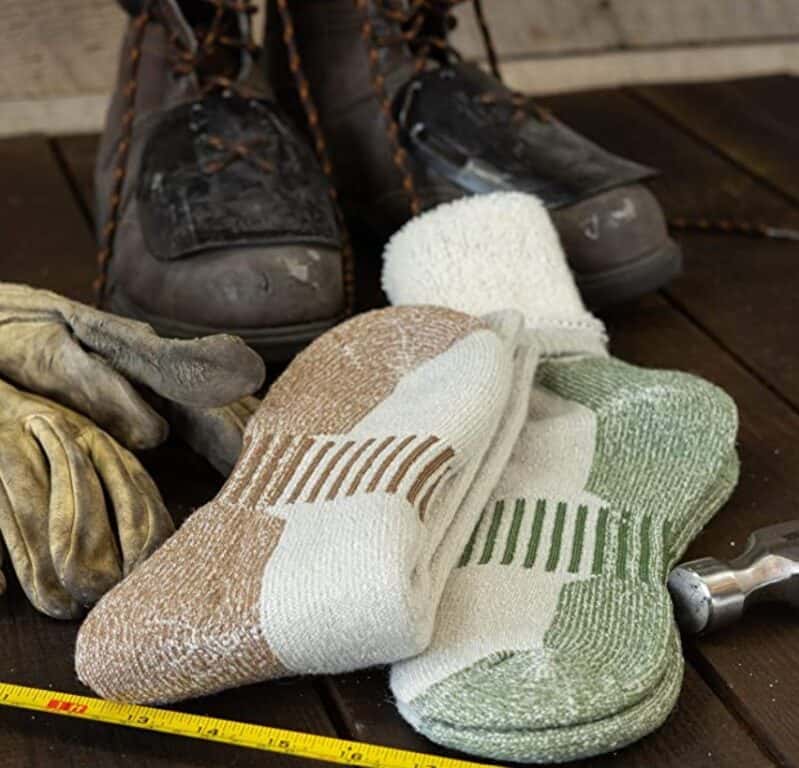
Alternatives to Wool Socks
Although wool is one of the most widely used sock materials for cold weather camping, some people just don’t like wool or find other materials more effective. Itchiness is a common complaint regarding traditional wool, and some argue that certain synthetic materials are warmer.
There’s no inherently correct answer here, and what sock material you find most useful will depend entirely on your personal preferences.
Some common alternatives to traditional wool socks include:
- Merino Wool
- Fleece
- Down booties
- Neoprene toe warmers
We have some recommendations of what are the best socks for camping and hiking in our article, Do Hiking Sock Liners Prevent Blisters? – What Hikers Really Use.
In that article, we recommend Injinji Liner Crew Toesocks as the best synthetic hiking sock. You can see the current price of these socks on Amazon here.

Go Barefoot
Although most people suggest wearing some form of sock or foot covering while hammock camping, there’s a group of people who swear that their feet stay warmer when barefoot.
There are two primary justifications for this theory.
The first reason is that socks cause your feet to sweat, and the second is that socks constrict blood flow to the feet.
It’s generally agreed that wet feet=cold feet. So, if you tend to have sweaty feet, you may be better off ditching the socks entirely in order to avoid trapping the cooling moisture around your foot.
The less blood there is in your feet, the colder they will feel. Even the loosest fitting socks may constrict blood flow, and supporters of the barefoot philosophy will argue that any loss in blood flow is ultimately not worth the short term warmth provided by a sock.
If you plan on testing the barefoot theory out for yourself, it’s strongly suggested you make sure your feet are completely dry before getting into your hammock and that you use alternative methods to keep your feet warm.
Add Insulation
Adding insulation to stay warm in your hammock might seem like a no-brainer. There are methods to properly do it for your best chance of staying warm in your hammock all night.
Hammock Underquilt
An underquilt is a blanket attached to the suspension line that covers the underneath your hammock. Similar to a sleeping bag, it’s made with a nylon or polyester outer shell and stuffed with either a down or synthetic insulating material.
The underquilt helps add an incredibly useful layer of insulation between your hammock and the cold ground.
It covers the length of the hammock, which means that the underquilt not only provides insulation beneath your feet. It also adds insulation for your entire body, which will, in turn, help keep your feet warm.
Good quality underquilts seem quite expensive. A lot of down feathers (Wikipedia) are used to make these, think of the price of six or seven high quilty down jackets to make one underquilt, and they seem a little more reasonable. Eagles Nest Outfitters Blaze UnderQuilt will keep you warm in a hammock down to around 30 degrees Fahrenheit.
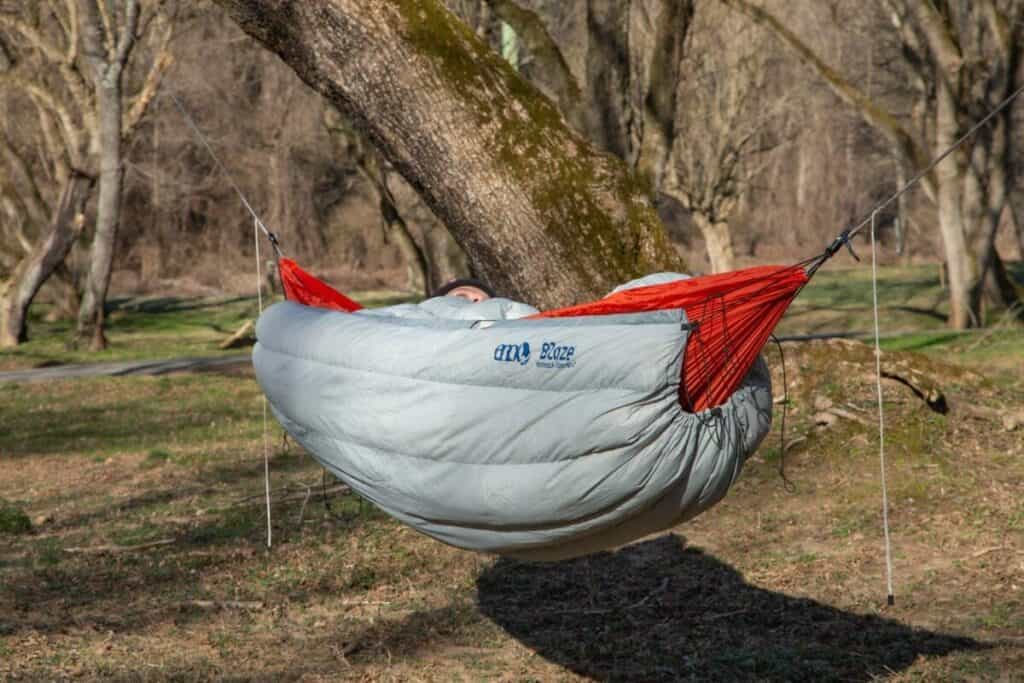
See if the ENO Underquilt is available on Amazon here.
Sleep or Sit Pad (or both)
Whether you prefer a closed-cell foam (CCF) or inflatable pad, using a sleep or sit pad in your hammock is a popular method of adding insulation to your sleeping setup.
Laying on top of a full-body sleep pad while in a hammock creates a layer of insulation for your entire body.
Like the underquilt, this creates the dual benefit of helping your body retain heat, which prevents blood loss from the extremities, as well as providing a direct layer of insulation beneath your feet.
For people who prefer the direct feel of a hammock beneath them, placing the smaller sit pad underneath their feet helps provide a more isolated form of insulation.
If you really want to double up on the insulation, nothing stops you from using a full-body sleeping pad and placing a sit pad under your feet. Whatever works and feels comfortable for you is all that matters!
The Winter Camping Coat Trick
This is a relatively simple but ingenious little trick. Just zip your jacket, down parka, or any other type of winter coat you have completely around the foot of the hammock under the ridgeline.
This helps to insulate and trap heat both above and below your feet.
Pro tip: Tuck the sleeves into the coat for extra insulation.
Add Some Heat to Sleep Warmer in Your Hammock
While it’s difficult to use a portable heater for hammock camping there are a few ways to stay warm at night.
Chemical Foot Warmer
You’re probably familiar with these little heat packets. They contain iron, charcoal, and vermiculite and, when activated through oxidation, produce an intense heat that can last up to 8 hours.
If you’ve implemented all other feet warming/insulation methods and still find that your feet are cold, try placing a packet by your feet for additional warmth.
Chemical heat has a distinctly different feel from other forms of warmth. Some people love these, and some people hate them.
It’s highly recommended to test it out to see how you feel about them before choosing to rely on them for a trip.
It should also be noted that these warmers must never be placed on bare skin or in areas with generous oxygen flow. Misuse can result in burns. So, read the directions and be careful!
Check out these hand warmers on Amazon here.
Hot Water Bottle
The hot water bottle technique is straightforward but incredibly effective at adding warmth to your hammock sleeping setup.
All you need to do is put hot water into a bottle (Nalgene bottle is typically recommended), close it up tight, put a wool sock or some other fabric around it, and you’ve got a cozy bottle of warmth.
The bottle can be placed anywhere within your sleeping bag, but to have the most significant impact on the warmth of your feet, you can place it either by your feet or between your legs. Placing it between your legs (by your groin) helps warm the femoral artery, which increases blood flow to the feet.
A few words of caution here!
First, don’t put boiling water in the bottle. It could pressurize the bottle and cause it to explode. No joke, be careful here.
Second, make sure you trust the water bottle you’re using. Placing hot water in a cheap, leaky bottle is a terrible idea.
Invest in a good quality bottle and test it with hot water before placing it anywhere near your body. You can even place the water bottle in a Ziplock bag before putting a wool sock over it for extra precaution. A little extra precaution never hurts!
Wrapping Up
If you ask a handful of experienced hammock campers what their solution to this common problem is, you’re bound to get a mix of answers that often conflict with each other.
Although people may swear by their own personal method, it’s important to remember that this isn’t an exact science. What works for one person may not for the next.
There’s no, one-size-fits-all solution to keeping your feet warm in a hammock. The combination of methods, tools, and tricks that work best will be unique for everyone.
Now that you’re armed with a wide variety of options to keep your feet toasty warm get out there and see what works best for you!
If you’ve found a great method for keeping your feet warm while hammock camping, let us know down in the comment.

